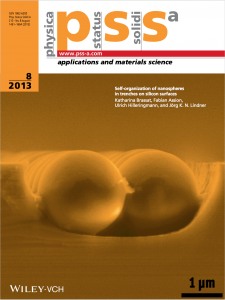Nanosphere lithography (NSL) is a bottom-up technique for the creation of large-area two-dimensional nanopattern arrays on material surfaces. Typical feature sizes of the patterns reach from 100 nm to 2000 nm.
Hexagonally close-packed monolayers of colloidal nanospheres are deposited onto surfaces, e.g. by convective self-assembly. These nanosphere monolayers are then used as shadow masks for the site-selective modification of the underlying substrate surface through the mask openings (principle in Fig. 1(a) [Optics Express]). These mask openings are triangular shaped for close-packed sphere layers, thus allow for the deposition of hexagonally arranged material nanotriangles. By modification of the mask openings, for instance by thermal or plasma treatment, versatile nanopatterns can be created.
 Controlled shrinking of polymer spheres in plasma processes prior to material deposition is used for the creation of antidot patterns, i.e. material thin films with hexagonally arranged circular free substrate areas (see Fig. 1(d), [Optics Express]). The polymer sphere monolayers can be produced on numerous surfaces (SiO2, TiO2, mica, Au, Ti-4V-6Al alloy) and various materials can then be deposited (Au, Pt, SiO2). Thus, the antidot patterns exhibit a periodically varying topography as well as material contrast which defines for instance reactive and inert sites (see sketch below).
Controlled shrinking of polymer spheres in plasma processes prior to material deposition is used for the creation of antidot patterns, i.e. material thin films with hexagonally arranged circular free substrate areas (see Fig. 1(d), [Optics Express]). The polymer sphere monolayers can be produced on numerous surfaces (SiO2, TiO2, mica, Au, Ti-4V-6Al alloy) and various materials can then be deposited (Au, Pt, SiO2). Thus, the antidot patterns exhibit a periodically varying topography as well as material contrast which defines for instance reactive and inert sites (see sketch below).
 In our publications in Physica Status Solidi and MRS online, we show, how NSL allows not only for the two-dimensional surface patterning but also for the creation of one-dimensional nanopatterns if combined with directed self-assembly of colloids. In these paper, we show how linear chains of polymer spheres can be deposited into trenches on silicon surfaces and how susequently rows of nanogap electrodes can be easily prepared at large amounts.
In our publications in Physica Status Solidi and MRS online, we show, how NSL allows not only for the two-dimensional surface patterning but also for the creation of one-dimensional nanopatterns if combined with directed self-assembly of colloids. In these paper, we show how linear chains of polymer spheres can be deposited into trenches on silicon surfaces and how susequently rows of nanogap electrodes can be easily prepared at large amounts.
